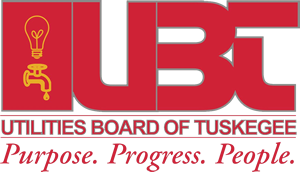For the first time since 2012, UBT will implement a rate adjustment for all residential customers effective November 1, 2025. This change will help ensure we continue to deliver the safe, reliable, and affordable utilities that the Tuskegee and Macon County communities depend on.
Introduction
We are excited to provide a comprehensive and user-friendly resource designed to empower you with the tools and knowledge you need for a seamless experience. The customer toolkit includes FAQs, utility assistance options, how-to videos, and more to help you find convenient solutions.
Have a Question?
Our Frequently Asked Questions section covers a wide array of topics, from general inquiries to service-related queries. Get instant answers without the wait.
Featured videos from Youtube
- FAQs
- WATCH VIDEO - Standard Residential Bill
- WATCH VIDEO - Residential Bill with a past-due balance
Bill Pay Assistance

UBT offers a Helping Hands program (Subject to funding) that is designed to help customers who are unable to pay their utility bills. Customers can donate to UBT’s Helping Hands program by adding a one-time or monthly contribution to their monthly utility bill. Please consider contributing to this worthwhile program. UBT also provides payment arrangements for customers who meet certain criteria, as follows (Not all-inclusive)
- New customers cannot qualify for his/her first utility bill
- A customer who has tempered with meter or committed unauthorized practice or act
- Customers who has granted an arrangement must enter into a signed payment arrangement agreement.
- If service has been discontinued due to non-payment, customer will be required to pay fifty percent (50%) of the amount owed.
- The customer’s history will be reviewed in order to determine whether granting of payment arrangement will pose too a great risk of loss to the company
- Additional fee may apply
For more information, contact UBT’s Customer Service Department online here,
or call 334.720.0700.
Macon-Russell Community Action Agency, Inc. at https://mrcaa.org is the main source for utility assistance.
Water Leak Prevention and Detection

The leak detection tips are designed to equip you with the knowledge and tools you need to effectively manage leaks in your home. By staying informed and proactive, you can safeguard your property, conserve water, and avoid the headaches that come with plumbing issues.
Water Leak Prevention and Detection
Water leaks can cause a tremendous amount of damage to your home and belongings if not repaired in a timely manner. Water stains on the ceilings, walls, or floors are usually the first signs that you have a water leak. But what if you can’t see any obvious signs? Here are ways to find hidden leaks in your home before calling for water leak repair.
Water Meter Test
One way to find hidden water leaks is to conduct a water meter test. Turn off all the faucets in your home and check the water meter. If the meter is still running, you have a water leak. Although you may not see a change right away in the water meter reading, check again after a couple of hours and compare the readings. If the water meter moved, you may be having a slow-moving leak.
Water Pressure Test
Another way to find hidden water leaks is to test the water pressure in your home. Turn off all the faucets and measure the water pressure. If the pressure is lower than normal, you may have a water leak.
Listen for Running Water
If you can’t see any obvious signs of a water leak, you can listen for running water. Water leaks can sometimes be heard through walls or floors.
Check your Appliances for Leaks
When checking for water leaks from appliances, disconnect all of them from the outlet until you find the appliance that has a leak. Water from a faulty appliance might be dripping slowly.
Check Your Toilet for Leaks
To check for water leaking from your toilets, drop a little food coloring into the tank overnight. If there’s color in the bowl without flushing by morning, you have a leaky toilet.
Check Your Utility Bills
Your water bill can sometimes give you hints about a possible water leak. If you see a sudden or unusual increase in your water usage, you may have a water leak. Mysuage allows you to track your consumption of water in real-time. Download the app or go online at www.myusage.com.
Water Drips and Wet Walls
If household members notice visible dampness around your kitchen, bathroom or laundry area, you might have a water leak. Water leaks can cause a mess in your home and allow mold to grow if you don’t fix it in time.
If any of these methods reveal that you have a water leak in your home, schedule a water leak repair with a trusted local plumber immediately to prevent water damage.
FAQs
Protect Your Home from
Cross-Contamination

Your home may unwittingly harbor sources of cross-contamination, posing risks to your family and neighbors.
Protect Your Home from Cross-Contamination
Keywords about cross-contamination:
- Backflow - is a reversal of the normal flow of water.
- Cross-Connection - a physical connection between drinkable water and a liquid, chemical, or gas that could make the water unsafe to drink (wherever there is a cross connection, there is a potential threat to public health)
- Backpressure - when the customer's pressure exceeds the supply pressure.
- Back-Siphonage - when the supply line pressure falls below atmospheric pressure.
How to Protect Your Home
Garden Hose Dangers
The humble garden hose can inadvertently contaminate your water supply in several ways:
- Direct attachment to a garden sprayer for pesticide or fertilizer application.
- Connection to a soap and brush for car washing.
- Submerging the hose end in puddles or pools.
Prevent these risks by installing a hose-bibb vacuum breaker on your outdoor faucet.
Irrigation Systems
For homes with irrigation systems, proper backflow prevention assemblies are essential. If you lack this safeguard, certified testers and installers can assist you. Remember, annual testing ensures ongoing effectiveness.
Swimming Pool Hazards
Chlorine and other pool chemicals can compromise water quality. Even filling pools with a garden hose creates a cross-connection risk.
Protect Your Well
Ground wells require backflow prevention measures to safeguard against contamination. Safeguard your property and community—take proactive steps against cross-contamination today.
Energy Saving Tips - Spring and Summer

Welcome to our Energy-Saving Sanctuary! In this oasis of efficiency, we're dedicated to empowering you with savvy strategies to shrink your electricity bills without sacrificing comfort or convenience. Dive in and discover practical tips, hacks, and eco-conscious insights to lighten the load on both your wallet and the planet. Let's spark a brighter, more efficient tomorrow together!
Energy Saving Tips
Use Your Windows To keep out Heat
- Install window coverings to prevent heat gain through your windows during the day.
Operate Your Thermostat Efficiently
- Set your thermostat at a temperature you find comfortable and that provides humidity control if needed. The smaller the difference between the indoor and outdoor temperatures, the lower your overall cooling bill will be.
- Keep your house warmer than normal when you are away and lower the thermostat setting when you return home and need cooling. A programmable thermostat allows you to do this automatically and without sacrificing comfort.
- Avoid setting your thermostat at a colder setting than normal when you first turn on your air conditioner. It will not cool your home any faster and could result in excessive cooling and unnecessary expense
Use Your Windows To keep out Heat
- Turn off ceiling fans when you leave the room. Remember that fans cool people, not rooms, by creating a wind chill effect.
- When you shower or take a bath, use the bathroom fan to remove heat and humidity from your home. Your laundry room might also benefit from spot ventilation. Make sure bathroom and kitchen fans are vented to the outside (not just to the attic).
- Find ENERGY STAR ventilating fans.
Keep your Cooling System Running Efficiently
- For maximum energy affordability, schedule regular maintenance for your cooling equipment.
- Avoid placing lamps or TV sets near your room air-conditioning thermostat. The thermostat senses heat from these appliances, which can cause the air conditioner to run longer than necessary.
- Vacuum your air intake vents regularly to remove any dust buildup. Ensure that furniture and other objects are not blocking the airflow through your registers.
Consider a range of Appliances and Lighting Options
- Consider lighting options that operate at cooler temperatures.
- If convenient, take advantage of daylight instead of artificial lighting, but avoid direct sunlight.
- Wash full loads of dishes and clothes for better efficiency.
Keep Hot Air From Leaking into your Home
- Seal cracks and openings to prevent warm air from leaking into your home.
- Learn more about air sealing new and existing homes.
- Add caulk or weatherstripping to seal air leaks around doors and windows.
Lower your Water Heating Costs
- Water heating accounts for about 18% of the energy consumed in your home.
- The Consumer Product Safety Commission recommends setting your water heater at no more than 120 degrees Fahrenheit to prevent scalding.
- The lower setting will also conserve energy and save money.
You can reduce your water heating bills in four primary ways:
- Using less hot water
- Using energy-saving strategies, such as turning down the thermostat on your water heater
- Insulating your water heater and pipes
- Buying a new, more efficient model or type of water heater.
UBT's Electric System

UBT manages an electrical transmission and distribution system serving around 6,694 customers across a 103-square-mile service area in Macon County. This system caters to both residential and commercial clients, with residential customers making up about 90% of the total. The three largest electric customers are Tuskegee University, VictoryLand, and the VA Hospital.
UBT's Water System

UBT supplies drinking water to approximately 4,163 customers, primarily within the city limits of Tuskegee. The system includes a raw water pumping station on the Tallapoosa River, a water treatment plant with a capacity of 4 million gallons per day, and an extensive network of water distribution pipes. Major water customers include Tuskegee University, the VA Hospital, and Love’s Travel Stops, and Country Stores.
UBT's Wastewater System

UBT provides wastewater services to around 3,593 customers, mainly within Tuskegee's city limits. The infrastructure comprises two wastewater treatment plants (North and South Sewage Treatment Plants), seven pumping stations, and an extensive sewer network.

